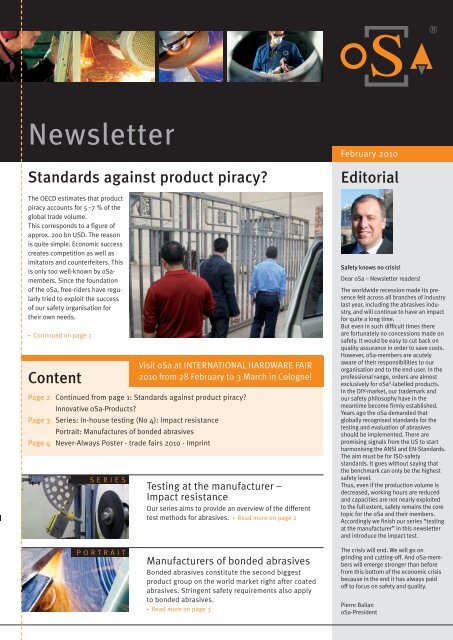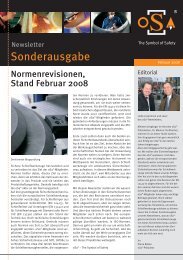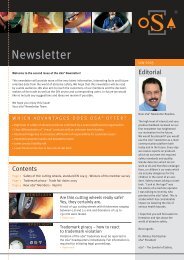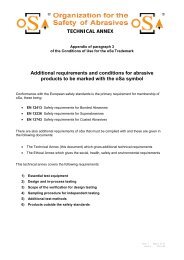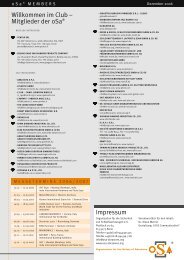7. oSa Newsletter - Organisation für die Sicherheit von ...
7. oSa Newsletter - Organisation für die Sicherheit von ...
7. oSa Newsletter - Organisation für die Sicherheit von ...
You also want an ePaper? Increase the reach of your titles
YUMPU automatically turns print PDFs into web optimized ePapers that Google loves.
<strong>Newsletter</strong><br />
February 2010<br />
Standards against product piracy?<br />
The OECD estimates that product<br />
piracy accounts for 5–7 % of the<br />
global trade volume.<br />
This corresponds to a figure of<br />
approx. 200 bn USD. The reason<br />
is quite simple. Economic success<br />
creates competition as well as<br />
imitators and counterfeiters. This<br />
is only too well-known by <strong>oSa</strong>members.<br />
Since the foundation<br />
of the <strong>oSa</strong>, free-riders have regularly<br />
tried to exploit the success<br />
of our safety organisation for<br />
their own needs.<br />
• Continued on page 2<br />
Content<br />
Page 2<br />
Page 3<br />
Page 4<br />
Continued from page 1: Standards against product piracy?<br />
Innovative <strong>oSa</strong>-Products?<br />
Series: In-house testing (No 4): Impact resistance<br />
Portrait: Manufactures of bonded abrasives<br />
Never-Always Poster - trade fairs 2010 - Imprint<br />
S E R I E S<br />
Visit <strong>oSa</strong> at INTERNATIONAL HARDWARE FAIR<br />
2010 from 28 February to 3 March in Cologne!<br />
Testing at the manufacturer –<br />
Impact resistance<br />
Our series aims to provide an overview of the different<br />
test methods for abrasives. • Read more on page 2<br />
Editorial<br />
Safety knows no crisis!<br />
Dear <strong>oSa</strong> – <strong>Newsletter</strong> readers!<br />
The worldwide recession made its presence<br />
felt across all branches of industry<br />
last year, including the abrasives industry,<br />
and will continue to have an impact<br />
for quite a long time.<br />
But even in such difficult times there<br />
are fortunately no concessions made on<br />
safety. It would be easy to cut back on<br />
quality assurance in order to save costs.<br />
However, <strong>oSa</strong>-members are acutely<br />
aware of their responsibilities to our<br />
organisation and to the end-user. In the<br />
professional range, orders are almost<br />
exclusively for <strong>oSa</strong> ® -labelled products.<br />
In the DIY-market, our trademark and<br />
our safety philosophy have in the<br />
meantime become firmly established.<br />
Years ago the <strong>oSa</strong> demanded that<br />
globally recognised standards for the<br />
testing and evaluation of abrasives<br />
should be implemented. There are<br />
promising signals from the US to start<br />
harmonising the ANSI and EN-Standards.<br />
The aim must be for ISO-safety<br />
standards. It goes without saying that<br />
the benchmark can only be the highest<br />
safety level.<br />
Thus, even if the production volume is<br />
decreased, working hours are reduced<br />
and capacities are not nearly exploited<br />
to the full extent, safety remains the core<br />
topic for the <strong>oSa</strong> and their members.<br />
Accordingly we finish our series “testing<br />
at the manufacturer” in this newsletter<br />
and introduce the impact test.<br />
P O R T R A I T<br />
Manufacturers of bonded abrasives<br />
Bonded abrasives constitute the second biggest<br />
product group on the world market right after coated<br />
abrasives. Stringent safety requirements also apply<br />
to bonded abrasives.<br />
• Read more on page 3<br />
The crisis will end. We will go on<br />
grinding and cutting-off. And <strong>oSa</strong>-members<br />
will emerge stronger than before<br />
from this bottom of the economic crisis<br />
because in the end it has always paid<br />
off to focus on safety and quality.<br />
Pierre Balian<br />
<strong>oSa</strong>-President
N E W S F L A S H<br />
February 2010<br />
Standards against product piracy? • Continued from page 1<br />
However, we actively fight against counterfeiters and forgers<br />
with the aid of our lawyer and, if need be, by taking court action.<br />
In China and soon in further hub markets, the security service<br />
provider “Pinkerton Consulting & Investigations” supports us in<br />
closing down the factories of counterfeit manufacturers and<br />
detecting the trade flows of pirate copies and counterfeits.<br />
Contrary to T-shirts and sneakers, abrasive counterfeits not only<br />
damage the business of the original manufacturer but also pose a<br />
serious safety risk to the end-user often resulting in fatal injury.<br />
With great interest, <strong>oSa</strong> pursues initiatives emanating from the ISO<br />
to set up globally valid standards for the quick identification of<br />
counterfeits. Customs and police authorities are today often faced<br />
with the problem of having to quickly and accurately identify<br />
counterfeit products.<br />
Even <strong>oSa</strong>-members have difficulties in identifying them as counterfeit.<br />
It is therefore advantageous that <strong>oSa</strong>-representatives are able<br />
to participate in the respective ISO Standards Committees where<br />
they can represent the interests of our members. We can only hope<br />
that solutions will be implemented there which also help <strong>oSa</strong>members<br />
to protect their products reliably against counterfeits or at<br />
least will make the detection of counterfeits easier and more certain.<br />
Further information on this standardisation project can be obtained<br />
at the ISO-Secretariat ISO/PC 246 „Anti-counterfeiting tools“,<br />
which is operated by the French standards institute AFNOR. The<br />
current draft standard is: ISO WD 12931 „Performance criteria for<br />
authentication tools for anti-counterfeiting in the field of material<br />
goods“.<br />
Innovative <strong>oSa</strong>-products?<br />
You will say: Stop! It goes<br />
without saying that also <strong>oSa</strong> ® -<br />
labelled products are innovative.<br />
What does this topic<br />
have to do with a newsletter?<br />
But be careful! The three EN-<br />
Safety Standards form the<br />
basic pillar of our safety philosophy.<br />
So far it was strictly<br />
regulated that only abrasives<br />
covered by the standards could<br />
be labelled with our protected<br />
trademark. And anyone who<br />
knows about standardisation<br />
processes is well aware that<br />
they need considerable time to<br />
formulate or modify.<br />
Time, on the other hand, is a<br />
factor that innovations lack, as<br />
they basically deal with the<br />
quick conversion of new technical<br />
and economic findings<br />
into product benefit. Someone<br />
who has found out how an<br />
abrasive can be considerably<br />
mproved, does not want to<br />
wait 5 years until the next<br />
standards revision.<br />
The product life cycles demand<br />
that the innovative tool is<br />
placed on the market quickly.<br />
The conflict of objectives lies<br />
in putting the innovation into<br />
practice for the end-user but<br />
at the same time making no<br />
concessions on the high safety<br />
requirements of the <strong>oSa</strong>.<br />
The Technical Working Group<br />
(TWG) has tackled this topic in<br />
detail. Experts from our member<br />
companies together with<br />
our independent inspectors<br />
have found a feasible way how<br />
it can be assured that product<br />
innovations fulfil all <strong>oSa</strong>-requirements.<br />
The manufacturer basically<br />
must take three steps to turn<br />
the innovative abrasive product<br />
into an approved product<br />
under the <strong>oSa</strong>-safety umbrella:<br />
1. Risk assessment – which<br />
dangers for the end-user can<br />
emanate from the new product?<br />
2. Identify which product<br />
already covered by the EN-<br />
Safety Standards has similarities<br />
to the new abrasive tool<br />
3. Prove that the requirements<br />
stipulated for this „conservative“<br />
product are also met by<br />
the innovative tool and, even<br />
better, exceeded<br />
For legal reasons, it will be<br />
impossible to label such abrasives<br />
with both <strong>oSa</strong> ® -trademark<br />
and EN-number. It must<br />
therefore be our aim to take<br />
innovative products into consideration<br />
at the next regular<br />
standards revision and to<br />
adopt them into the standards.<br />
The Board of Trustees put this<br />
new regulation into effect at its<br />
autumn meeting 2009.<br />
All members will be informed<br />
about the exact procedure of<br />
including innovative abrasives<br />
into the <strong>oSa</strong>-scope of products.<br />
Calculation of mounted points by means of the finite element method<br />
Geopolymers – a new bond?
S E R I E S T E S T I N G B Y T H E M A N U F A C T U R E R<br />
February 2010<br />
Part 4: Impact resistance<br />
Our series aims to provide an<br />
overview of the different test<br />
methods for abrasives. The<br />
requirements of the safety<br />
standards are high, based on<br />
a decade-long experience<br />
accumulated by independent<br />
test institutes. It is the overall<br />
aim to ascertain that even in<br />
case of foreseeable misuse an<br />
abrasive will have resistance<br />
to failure. The protection of<br />
the end-user is the first<br />
priority for all <strong>oSa</strong>-members.<br />
So far we presented the burst<br />
speed test, the destructive<br />
segment test for diamond<br />
cutting-off wheels and dish<br />
wheels as well as the side load<br />
test. In the last newsletter<br />
we explained the single and<br />
three-point side load test.<br />
These tests provide information<br />
on the resistance of abrasives<br />
to side load and jamming.<br />
These two test methods are<br />
supplemented by the impact<br />
resistance that measures the<br />
resistance of the wheel to<br />
sudden lateral shock. This test<br />
is mandatory for all resinoid<br />
bonded depressed centre<br />
wheels (ISO-type 27, 28 and<br />
29) as well as for depressed<br />
and straight cutting-off wheels<br />
(type 41 and 42), 150 mm<br />
diameter and above, for use<br />
on hand-held machines.<br />
The test principle is easy. The<br />
test sample is mounted to a<br />
spindle by means of flanges<br />
and then taken up to its<br />
maximum operating speed.<br />
The rotating abrasive is<br />
laterally subjected to one<br />
or several impacts supplied<br />
successively by means of a<br />
pendulum until failure. Details<br />
on the implementation of<br />
the tests can be taken from<br />
the EN 12413.<br />
Picture 1 shows the pendulum<br />
Picture 1: Pendulum<br />
applied at the IFA (formerly<br />
BGIA). The impact energy can<br />
be adjusted by changing the<br />
drop height or by loading<br />
additional mass.<br />
Picture 2: Breakage into several pieces<br />
One typical damage pattern<br />
is shown in picture 2. Besides<br />
regular function checks, the<br />
calibration of the test stand in<br />
certain intervals is important.<br />
For example, dirt that got into<br />
the bearing can increase the<br />
bearing friction and thus minimize<br />
the drop energy that<br />
impacts the abrasive. The IFA<br />
recommends to have the pendulum<br />
calibrated by an external<br />
institute at least once a year.<br />
M E M B E R<br />
P O R T R A I T<br />
Manufacturers of bonded abrasives<br />
Bonded abrasives are one of<br />
the most common and well<br />
known of the abrasive groups.<br />
Since grinding is one of the<br />
oldest manufacturing<br />
processes, you will be bound<br />
Mounted points<br />
to have come across this<br />
product group at some time.<br />
These products are also of<br />
major importance to <strong>oSa</strong>. One<br />
factor that all these bonded<br />
abrasives have in common is<br />
that they utilise conventional<br />
abrasives such as aluminium<br />
oxide and silicon carbide,<br />
not diamond or cubic boron<br />
nitride. There are also the<br />
newer zirconia-alumina and<br />
sol gel abrasives. Originally,<br />
there were numerous natural<br />
hard materials used such as<br />
sandstone, garnet, emery and<br />
corundum but these were<br />
found to be too inconsistent<br />
for modern requirements.<br />
The abrasive grains are held<br />
together by a bond. The type<br />
and nature of the bond determines<br />
the grinding characteristics<br />
obtained. There are<br />
several bond types available.<br />
Among the inorganic bond<br />
types, the ceramic or vitrified<br />
bond plays the decisive role<br />
within <strong>oSa</strong>. The use of silicate<br />
and magnesite bonds has<br />
diminished considerably in<br />
recent times.<br />
The most common of the<br />
organic bonds is resinoid<br />
bond, normally a phenolic<br />
(Bakelite). Less popular are<br />
rubber, shellac, epoxy or<br />
thermo-plastic bond types.<br />
With a market share of an<br />
estimated 2.2 bn. USD (as of<br />
2004), bonded abrasives<br />
constitute the second biggest<br />
product group after coated<br />
abrasives. Although the handheld<br />
and mobile machines<br />
present the greatest safety<br />
risks, stringent safety requirements<br />
also apply to stationary<br />
machines. For example, an<br />
abrasive wheel for highpressure<br />
steel conditioning<br />
can easily weigh several ten<br />
kilos and operates at speeds<br />
up to 80 m/s. Its bursting<br />
would have serious consequences,<br />
not only for the<br />
worker, (since not all machines<br />
are totally-enclosed), but<br />
also the machine could be<br />
badly damaged.<br />
Grinding process<br />
There are currently 25 manufacturers<br />
of bonded abrasives<br />
who are members of <strong>oSa</strong>.<br />
Many of them have played a<br />
decisive role as founding<br />
members in formulating the<br />
<strong>oSa</strong>-safety philosophy.<br />
Substantial aspects of this<br />
philosophy also found entry<br />
into the European Safety<br />
Standard, EN 12413. This<br />
standard was revised in 2007<br />
and now offers a solid basis<br />
for the self-certification of the<br />
<strong>oSa</strong>-members. The <strong>oSa</strong>-trademark<br />
on an abrasive wheel<br />
provides the end-user with a<br />
sense of security as it indicates<br />
a product with a high and<br />
verifiable level of safety.<br />
Vitrified bonded wheel
M A J O R<br />
T O P I C<br />
February 2010<br />
Now available: Never-Always Poster<br />
Occupational health and safety<br />
is a major concern for <strong>oSa</strong>.<br />
This includes informing the enduser<br />
of the dangers involved in<br />
the incorrect use of abrasives.<br />
Correctly labelled products and<br />
the information for safe use<br />
which must be supplied with<br />
each product have already had<br />
a big effect.<br />
Members now have the<br />
opportunity to obtain our new<br />
„Never-Always-Posters“ to<br />
inform customers and end-users<br />
on the safe use of their products.<br />
By doing so, <strong>oSa</strong>-members comply<br />
with their responsibilities,<br />
reducing their personal liability<br />
risk for improper use of their<br />
products and improve customer<br />
satisfaction.<br />
And finally these posters provide<br />
a real contribution to reducing<br />
accidents.<br />
Ten thousands of posters have been ordered<br />
so far. They are available for bonded abrasives<br />
(precision grinding as well as hand-held<br />
grinding and cutting-off) and diamond saws<br />
in sizes A0 and A1. Posters for further product<br />
groups are planned.<br />
To place an order please contact:<br />
monika.hesse@osa-abrasives.org<br />
© <strong>oSa</strong> 2009<br />
T R A D E F A I R D A T E S 2 0 0 9<br />
annually<br />
CIHF - CHINA INTERNATIONAL<br />
10 – 12 March 2010 Hardware & Welding Fair Shanghai/China<br />
every two years INTERTECH<br />
15 – 17 March 2010 International technical conference on diamond,<br />
cubic boron nitride and their applications<br />
Henderson, Nevada, USA<br />
every two years GRINDTEC<br />
17 – 20 March 2010 International Trade Fair for Grinding Technology<br />
Augsburg/Germany<br />
annually<br />
CARRARA MARMOTEC<br />
19 – 22 May 2010 International Fair for Marble, Carrara/Italy<br />
every two years AMB<br />
28 Sept. – 02 Oct. 10 International Exhibition for Metal Working<br />
Stuttgart/Germany<br />
every two years GLASSTEC<br />
28 Sept. – 02 Oct. 10 21 th international trade fair<br />
Düsseldorf/Germany<br />
every two years EUROBLECH<br />
October 2010 International Sheet Metal Working Technology<br />
Exhibition, Hanover/Germany<br />
N E W S<br />
Tradefair attendance of <strong>oSa</strong> at<br />
INTERNATIONAL HARDWARE FAIR 2010<br />
After a successful tradefair attendance in 2008, the <strong>oSa</strong> will again<br />
be present at the INTERNATIONAL HARDWARE FAIR 2010 from 28<br />
February to 3 March in Cologne: Hall 10.2, Aisle A, Booth No. 020.<br />
Together with the co-exhibitor IFA – Institute for Occupational<br />
Safety and Health of the German Social Accident Insurance based<br />
in Sankt Augstin/Germany (re-named from BGIA to IFA on 1 January<br />
2010), the <strong>oSa</strong> will provide ample and hands-on information on<br />
testing of abrasives. We are looking forward to meeting you there!<br />
Imprint<br />
<strong>Organisation</strong> für <strong>die</strong> <strong>Sicherheit</strong><br />
<strong>von</strong> Schleifwerkzeugen e.V.<br />
Postfach 75 64<br />
D-53075 Bonn<br />
Telephone +49(o)228-944 99-415<br />
Fax +49(o)228-944 99-728<br />
info@osa-abrasives.org<br />
www.osa-abrasives.org<br />
Responsible for content:<br />
Dr. Klaus Werner<br />
Design:<br />
CORE Communication ® – MedMedia GmbH


